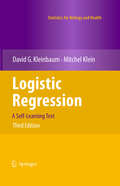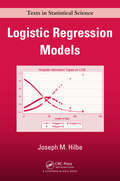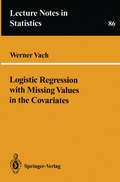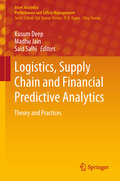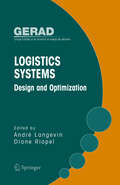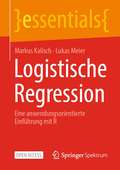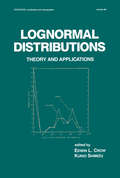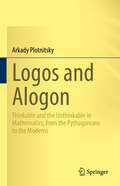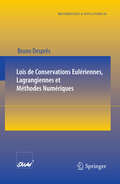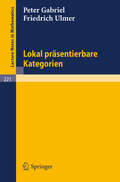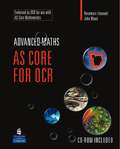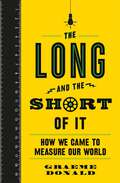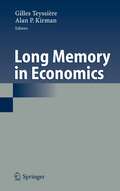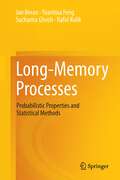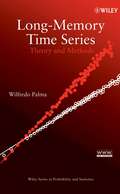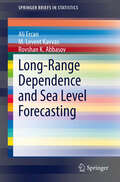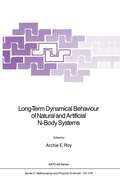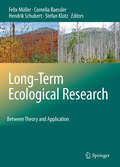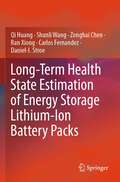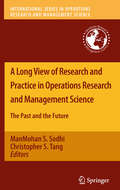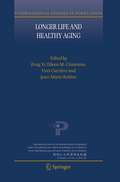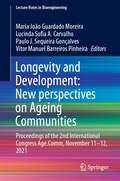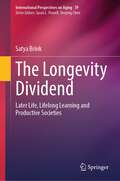- Table View
- List View
Logistic Regression: A Self-Learning Text (Statistics for Biology and Health)
by David G. Kleinbaum Mitchel KleinThis is the third edition of this text on logistic regression methods, originally published in 1994, with its second e- tion published in 2002. As in the first two editions, each chapter contains a pres- tation of its topic in “lecture?book” format together with objectives, an outline, key formulae, practice exercises, and a test. The “lecture book” has a sequence of illust- tions, formulae, or summary statements in the left column of each page and a script (i. e. , text) in the right column. This format allows you to read the script in conjunction with the illustrations and formulae that highlight the main points, formulae, or examples being presented. This third edition has expanded the second edition by adding three new chapters and a modified computer appendix. We have also expanded our overview of mod- ing strategy guidelines in Chap. 6 to consider causal d- grams. The three new chapters are as follows: Chapter 8: Additional Modeling Strategy Issues Chapter 9: Assessing Goodness of Fit for Logistic Regression Chapter 10: Assessing Discriminatory Performance of a Binary Logistic Model: ROC Curves In adding these three chapters, we have moved Chaps. 8 through 13 from the second edition to follow the new chapters, so that these previous chapters have been ren- bered as Chaps. 11–16 in this third edition.
Logistic Regression Models (Chapman And Hall/crc Texts In Statistical Science Ser.)
by Joseph M. HilbeLogistic Regression Models presents an overview of the full range of logistic models, including binary, proportional, ordered, partially ordered, and unordered categorical response regression procedures. Other topics discussed include panel, survey, skewed, penalized, and exact logistic models. The text illustrates how to apply the various models t
Logistic Regression with Missing Values in the Covariates (Lecture Notes in Statistics #86)
by Werner VachIn many areas of science a basic task is to assess the influence of several factors on a quantity of interest. If this quantity is binary logistic, regression models provide a powerful tool for this purpose. This monograph presents an account of the use of logistic regression in the case where missing values in the variables prevent the use of standard techniques. Such situations occur frequently across a wide range of statistical applications. The emphasis of this book is on methods related to the classical maximum likelihood principle. The author reviews the essentials of logistic regression and discusses the variety of mechanisms which might cause missing values while the rest of the book covers the methods which may be used to deal with missing values and their effectiveness. Researchers across a range of disciplines and graduate students in statistics and biostatistics will find this a readable account of this.
Logistics, Supply Chain and Financial Predictive Analytics: Theory and Practices (Asset Analytics)
by Kusum Deep Madhu Jain Said SalhiThis book addresses a broad range of problems commonly encountered in the fields of financial analysis, logistics and supply chain management, such as the use of big data analytics in the banking sector. Divided into twenty chapters, some of the contemporary topics discussed in the book are co-operative/non-cooperative supply chain models for imperfect quality items with trade-credit financing; a non-dominated sorting water cycle algorithm for the cardinality constrained portfolio problem; and determining initial, basic and feasible solutions for transportation problems by means of the “supply demand reparation method” and “continuous allocation method.” In addition, the book delves into a comparison study on exponential smoothing and the Arima model for fuel prices; optimal policy for Weibull distributed deteriorating items varying with ramp type demand rate and shortages; an inventory model with shortages and deterioration for three different demand rates; outlier labeling methods for medical data; a garbage disposal plant as a validated model of a fault-tolerant system; and the design of a “least cost ration formulation application for cattle”; a preservation technology model for deteriorating items with advertisement dependent demand and trade credit; a time series model for stock price forecasting in India; and asset pricing using capital market curves. The book offers a valuable asset for all researchers and industry practitioners working in these areas, giving them a feel for the latest developments and encouraging them to pursue further research in this direction.
Logistics Systems: Design and Optimization (Gerad 25th Anniversary Ser.)
by Diane Riopel André LangevinIn a context of global competition, the optimization of logistics systems is inescapable. Logistics Systems: Design and Optimization falls within this perspective and presents twelve chapters that well illustrate the variety and the complexity of logistics activities. Each chapter is written by recognized researchers who have been commissioned to survey a specific topic or emerging area of logistics. The first chapter, by Riopel, Langevin, and Campbell, develops a framework for the entire book. It classifies logistics decisions and highlights the relevant linkages to logistics decisions. The intricacy of these linkages demonstrates how thoroughly the decisions are interrelated and underscores the complexity of managing logistics activities. Each of the chapters focus on quantitative methods for the design and optimization of logistics systems.
Logistische Regression: Eine anwendungsorientierte Einführung mit R (essentials)
by Markus Kalisch Lukas MeierDieses Open-Access-Buch gibt eine anwendungsorientierte Einführung in die logistische Regression. Ausgehend von Grundkenntnissen der linearen Regression wird diese zuerst als zweistufiges Modell interpretiert, was den Übergang zur logistischen Regression vereinfacht. Neben einer kompakten Einführung der entsprechenden Theorie liegt der Fokus auch auf der Umsetzung mit der Statistiksoftware R und der richtigen Formulierung der entsprechenden Ergebnisse. Alle Schritte werden anhand zahlreicher Beispiele illustriert. Hinzu kommt eine Einführung in die Klassifikation mit den entsprechenden Begriffen.
Lognormal Distributions: Theory and Applications (Statistics: A Series Of Textbooks And Monographs)
by CrowPresenting the first comprehensive review of the subject's theory and applications inmore than 15 years, this outstanding reference encompasses the most-up-to-date advancesin lognormal distributions in thorough, detailed contributions by specialists in statistics,business and economics , industry, biology , ecology, geology, and meteorology.Lognormal Distributions describes the theory and methods of point and intervalestimation as well as the testing of hypotheses clearly and precisely from a modemviewpoint-not only for the basic two-parameter lognormal distribution but also for itsgeneralizations, including three parameters, truncated distributions, delta-lognormaldistributions, and two or more dimensions.Featuring over 600 references plus author and subject indexes, this volume rev iews thesubject's history .. . gives explicit formulas for minimum variance unbiased estimates ofparameters and their variances ... provides optimal tests of hypotheses and confidenceinterval procedures for various functions of the parameters in the two-parameter model. .. and discusses practical methods of analysis for truncated, censored, or groupedsamples.
Lognormal Distributions: Theory and Applications (Statistics: A Series Of Textbooks And Monographs)
by CrowPresenting the first comprehensive review of the subject's theory and applications inmore than 15 years, this outstanding reference encompasses the most-up-to-date advancesin lognormal distributions in thorough, detailed contributions by specialists in statistics,business and economics , industry, biology , ecology, geology, and meteorology.Lognormal Distributions describes the theory and methods of point and intervalestimation as well as the testing of hypotheses clearly and precisely from a modemviewpoint-not only for the basic two-parameter lognormal distribution but also for itsgeneralizations, including three parameters, truncated distributions, delta-lognormaldistributions, and two or more dimensions.Featuring over 600 references plus author and subject indexes, this volume rev iews thesubject's history .. . gives explicit formulas for minimum variance unbiased estimates ofparameters and their variances ... provides optimal tests of hypotheses and confidenceinterval procedures for various functions of the parameters in the two-parameter model. .. and discusses practical methods of analysis for truncated, censored, or groupedsamples.
Logos and Alogon: Thinkable and the Unthinkable in Mathematics, from the Pythagoreans to the Moderns
by Arkady PlotnitskyThis book is a philosophical study of mathematics, pursued by considering and relating two aspects of mathematical thinking and practice, especially in modern mathematics, which, having emerged around 1800, consolidated around 1900 and extends to our own time, while also tracing both aspects to earlier periods, beginning with the ancient Greek mathematics. The first aspect is conceptual, which characterizes mathematics as the invention of and working with concepts, rather than only by its logical nature. The second, Pythagorean, aspect is grounded, first, in the interplay of geometry and algebra in modern mathematics, and secondly, in the epistemologically most radical form of modern mathematics, designated in this study as radical Pythagorean mathematics. This form of mathematics is defined by the role of that which beyond the limits of thought in mathematical thinking, or in ancient Greek terms, used in the book’s title, an alogon in the logos of mathematics. The outcome of this investigation is a new philosophical and historical understanding of the nature of modern mathematics and mathematics in general. The book is addressed to mathematicians, mathematical physicists, and philosophers and historians of mathematics, and graduate students in these fields.
Lois de Conservations Eulériennes, Lagrangiennes et Méthodes Numériques (Mathématiques et Applications #68)
by Bruno DesprésLes systèmes de lois de conservation non linéaires modélisent les écoulements compressibles et incompressibles dans des domaines extrêmement variés tels que l'aéronautique, l'hydrodynamique, la physique des plasmas, la combustion, le trafic routier, l'élasticité non linéaire. Le cadre mathématique général est celui des systèmes de lois de conservation. Les exemples physiques sont nombreux et souvent spectaculaires. Cela contribue à fonder une nouvelle discipline, la Mécanique des Fluides Numérique. La présentation proposée porte l'accent sur les systèmes que l'on appellera lagrangiens ou écrits en coordonnées de Lagrange, sur leurs relations avec les systèmes en coordonnées d'Euler et sur les possibilités que cela offre pour la construction et l'analyse de schémas numériques entropiques. De nombreux exemples numériques sont présentés en liaison avec le contexte physique, ainsi que des exercices. It has long been observed that systems of conservation laws written in the Lagrange variable offer a good alternative for the numerical computation of approximate solutions. In this monograph we seek to develop a systematic presentation of the use of the Lagrange variable for the analysis and discretization of systems of conservation laws arising in continuum mechanics.
Lokal präsentierbare Kategorien (Lecture Notes in Mathematics #221)
by Peter Gabriel Friedrich UlmerLondman Advanced Maths: AS Core for OCR (PDF)
by John Wood Rosemary EmanuelLongman Advanced Mathematics is a series of comprehensive texts, with books for each of the OCR main courses that started in September 2004 The series develops core mathematical skills through an abundance of clear worked examples and progressive exercises, backed up by focused exam question practise and sample module papers.Covers all the A2 Core Modules C1 and C2 in one book.
Long and short, wide and narrow (tactile)
by Adrian FarnsworthThis is an eight-page tactile document of exercises intended to teach the concepts of long and short, and wide and narrow.
The Long and the Short of It: How We Came to Measure Our World
by Graeme DonaldWe’ve always measured the world around us, from how big things are, to how fast they go, how much they’re worth and practically everything in between. But who decided how we do it, and why?The Long and the Short of It takes us back in time to discover the origins and evolution of a huge variety of different units of measurement. On the way it answers such questions as:Why do we measure time in units of 60? How do you determine the height of a mountain when sea level keeps changing? Why did the length of a mile once depend on where you came from?What’s the width of a horse’s backside got to do with NASA’s booster rockets? Packed with fascinating stories, this is an intriguing guide to the many systems of measurement that make sense of our daily lives, from pounds and parsecs to bushels and barricades.
Long-Memory Processes: Probabilistic Properties and Statistical Methods
by Jan Beran Yuanhua Feng Sucharita Ghosh Rafal KulikLong-memory processes are known to play an important part in many areas of science and technology, including physics, geophysics, hydrology, telecommunications, economics, finance, climatology, and network engineering. In the last 20 years enormous progress has been made in understanding the probabilistic foundations and statistical principles of such processes. This book provides a timely and comprehensive review, including a thorough discussion of mathematical and probabilistic foundations and statistical methods, emphasizing their practical motivation and mathematical justification. Proofs of the main theorems are provided and data examples illustrate practical aspects. This book will be a valuable resource for researchers and graduate students in statistics, mathematics, econometrics and other quantitative areas, as well as for practitioners and applied researchers who need to analyze data in which long memory, power laws, self-similar scaling or fractal properties are relevant.
Long-Memory Time Series: Theory and Methods (Wiley Series in Probability and Statistics #662)
by Wilfredo PalmaA self-contained, contemporary treatment of the analysis of long-range dependent data Long-Memory Time Series: Theory and Methods provides an overview of the theory and methods developed to deal with long-range dependent data and describes the applications of these methodologies to real-life time series. Systematically organized, it begins with the foundational essentials, proceeds to the analysis of methodological aspects (Estimation Methods, Asymptotic Theory, Heteroskedastic Models, Transformations, Bayesian Methods, and Prediction), and then extends these techniques to more complex data structures. To facilitate understanding, the book: Assumes a basic knowledge of calculus and linear algebra and explains the more advanced statistical and mathematical concepts Features numerous examples that accelerate understanding and illustrate various consequences of the theoretical results Proves all theoretical results (theorems, lemmas, corollaries, etc.) or refers readers to resources with further demonstration Includes detailed analyses of computational aspects related to the implementation of the methodologies described, including algorithm efficiency, arithmetic complexity, CPU times, and more Includes proposed problems at the end of each chapter to help readers solidify their understanding and practice their skills A valuable real-world reference for researchers and practitioners in time series analysis, economerics, finance, and related fields, this book is also excellent for a beginning graduate-level course in long-memory processes or as a supplemental textbook for those studying advanced statistics, mathematics, economics, finance, engineering, or physics. A companion Web site is available for readers to access the S-Plus and R data sets used within the text.
Long-Range Dependence and Sea Level Forecasting (SpringerBriefs in Statistics)
by Ali Ercan M. Levent Kavvas Rovshan K. AbbasovThis study shows that the Caspian Sea level time series possess long range dependence even after removing linear trends, based on analyses of the Hurst statistic, the sample autocorrelation functions, and the periodogram of the series. Forecasting performance of ARMA, ARIMA, ARFIMA and Trend Line-ARFIMA (TL-ARFIMA) combination models are investigated. The forecast confidence bands and the forecast updating methodology, provided for ARIMA models in the literature, are modified for the ARFIMA models. Sample autocorrelation functions are utilized to estimate the differencing lengths of the ARFIMA models. The confidence bands of the forecasts are estimated using the probability densities of the residuals without assuming a known distribution.There are no long-term sea level records for the region of Peninsular Malaysia and Malaysia’s Sabah-Sarawak northern region of Borneo Island. In such cases the Global Climate Model (GCM) projections for the 21st century can be downscaled to the Malaysia region by means of regression techniques, utilizing the short records of satellite altimeters in this region against the GCM projections during a mutual observation period.This book will be useful for engineers and researchers working in the areas of applied statistics, climate change, sea level change, time series analysis, applied earth sciences, and nonlinear dynamics.
Long-Term Dynamical Behaviour of Natural and Artificial N-Body Systems (Nato Science Series C: #246)
by Archie E. RoyThe reader will find in this volume the Proceedings of the NATO Advanced Study Institute held in Cortina d'Ampezzo, Italy between August 3 and August 13, 1987 under the title "Long Term Dynamical Behaviour of Natural and Artificial N-body Systems". The Institute was the latest in a series held in 1972, 1975, 1978, 1981, 1984 in dynamical astronomy, theoretical mechanics and celestial mechanics under the Directorship of Professor Victor Szebehely. These previous institutes, held in high esteem by the international community of research workers, have resulted in a series of well-received and valuable Proceedings. In correspondence with Professor Szebehely and in long discussions with him in Colorado in August 1985, I agreed to his request that I undertake the preparation of a new ASI. I was happy to do so knowing I could call upon his vast experience in overseeing such ASI's. The last quarter century has been a period in which increasingly rapid progress has been made in celestial mechanics and related subjects not only because of the appearance of new problems urgently requiring solution but also because of the advent of new analytical techniques and powerful computer hardware and software.
Long-Term Ecological Research: Between Theory and Application
by Felix Müller Cornelia Baessler Hendrik Schubert Stefan KlotzEcosystems change on a multitude of spatial and temporal scales. While analyses of ecosystem dynamics in short timespans have received much attention, the impacts of changes in the long term have, to a great extent, been neglected, provoking a lack of information and methodological know-how in this area. This book fills this gap by focusing on studies dealing with the investigation of complex, long-term ecological processes with regard to global change, the development of early warning systems, and the acquisition of a scientific basis for strategic conservation management and the sustainable use of ecosystems. Within this book, theoretical ecological questions of long-term processes, as well as an international dimension of long-term monitoring, observations and research are brought together. The outcome is an overview on different aspects of long-term ecological research. Aquatic, as well as terrestrial ecosystems are represented.
Long-Term Health State Estimation of Energy Storage Lithium-Ion Battery Packs
by Qi Huang Shunli Wang Zonghai Chen Ran Xiong Carlos Fernandez Daniel-I. StroeThis book investigates in detail long-term health state estimation technology of energy storage systems, assessing its potential use to replace common filtering methods that constructs by equivalent circuit model with a data-driven method combined with electrochemical modeling, which can reflect the battery internal characteristics, the battery degradation modes, and the battery pack health state. Studies on long-term health state estimation have attracted engineers and scientists from various disciplines, such as electrical engineering, materials, automation, energy, and chemical engineering. Pursuing a holistic approach, the book establishes a fundamental framework for this topic, while emphasizing the importance of extraction for health indicators and the significant influence of electrochemical modeling and data-driven issues in the design and optimization of health state estimation in energy storage systems. The book is intended for undergraduate and graduate students who are interested in new energy measurement and control technology, researchers investigating energy storage systems, and structure/circuit design engineers working on energy storage cell and pack.
A Long View of Research and Practice in Operations Research and Management Science: The Past and the Future (International Series in Operations Research & Management Science #148)
by ManMohan S. Sodhi Christopher S. TangFrom the Foreword by Marshall Fisher, The Wharton School, University of Pennsylvania: As generation of academics and practitioners follows generation, it is worthwhile to compile long views of the research and practice in the past to shed light on research and practice going forward. This collection of peer-reviewed articles is intended to provide such a long view. This book contains a collection of chapters written by leading scholars/practitioners who have continued their efforts in developing and/or implementing innovative OR/MS tools for solving real world problems. In this book, the contributors share their perspectives about the past, present and future of OR/MS theoretical development, solution tools, modeling approaches, and applications. Specifically, this book collects chapters that offer insights about the following topics: • Survey articles taking a long view over the past two or more decades to arrive at the present state of the art while outlining ideas for future research. Surveys focus on use of a particular OR/MS approach, e.g., mathematical programming (LP, MILP, etc.) and solution methods for particular family of application, e.g., distribution system design, distribution planning system, health care. • Autobiographical or biographical accounts of how particular inventions (e.g., Structured Modeling) were made. These could include personal experiences in early development of OR/MS and an overview of what has happened since. • Development of OR/MS mathematical tools (e.g., stochastic programming, optimization theory). • Development of OR/MS in a particular industry sector such as global supply chain management. • Modeling systems for OR/MS and their development over time as well as speculation on future development (e.g., LINDO, LINGO, and What’sBest!) • New applications of OR/MS models (e.g., happiness) The target audience of this book is young researchers, graduate/advanced undergraduate students from OR/MS and related fields like computer science, engineering, and management as well as practitioners who want to understand how OR/MS modeling came about over the past few decades and what research topics or modeling approaches they could pursue in research or application.
Longer Life and Healthy Aging (International Studies in Population #2)
by Yi Zeng Eileen M. Crimmins Yves Carrière Jean-Marie RobineA fundamental issue facing the global community is meeting the challenges of population aging and achieving healthy aging to maintain an active older population and reduce the number of disabled people. The focus of this book is on theoretical issues and empirical findings related to trends and determinants of healthy aging, including factors related to "healthy longevity" of the oldest-old, aged 80 and over. The group is the most rapidly increasing elderly sub-population and is most likely to need assistance in daily living in all countries. Chapters include both longitudinal and cross-sectional data from North America, Europe, and Asia in country-specific studies and cross-national comparisons. Part I focuses on the definition, components, concepts, measurements, and determinants of healthy aging, and discusses the trends and patterns of disability and healthy life expectancy at the macro level. Part II addresses individual healthy aging, including its biological and socio-demographic aspects. Part III focuses on issues concerning the family and healthy aging, and Part IV explores formal and informal care for healthy aging through governmental policy interventions and community service programs.
Longevity and Development: Proceedings of the 2nd International Congress Age.Comm, November 11–12, 2021 (Lecture Notes in Bioengineering)
by Maria João Guardado Moreira Lucinda Sofia A. Carvalho Paulo J. Sequeira Gonçalves Vítor Manuel Barreiros PinheiraThis book focuses on the dynamic process of aging and on interventions to support the development of older and integrated societies, from a multidisciplinary point of view. Gathering contributions from researchers and professionals with different backgrounds, including social and health sciences, education, engineering and IT, biology, geography and environmental science, it aims at understanding the phenomenon of population aging, in order to contribute to the development of future functional communities, fostering well-being and autonomy of the elderly, their integration and participation. Based on the proceedings of the 2nd International Congress Age.Comm Longevity and Development, organised online on November 11-12, 2021, from Castelo Branco, Portugal, this book addresses a wide range of specialists dealing with the process of aging, integration and community development in the societies of the future.
The Longevity Dividend: Later Life, Lifelong Learning and Productive Societies (International Perspectives on Aging #39)
by Satya BrinkThis book offers global evidence about the increasing longevity, its consequences and its potential for societal benefits. Based on statistics, academic literature, policy initiatives and numerous country experiences, it explains the interconnected effects of a longer later life, lifelong learning and more productive societies. This larger picture shows how the future can be managed by making strategic choices today. Choosing the right policies allows gaining the maximum benefits from the longevity dividend for current and future generations. This book explains how investing in lifelong learning can enrich the longevity dividend. It gives valuable insights for policy advisors, decision makers, researchers, health professionals, practitioners, students of aging and late life educators.
